Your business is doing well locally and you are looking to ship overseas, but you don’t know where to start. Does this sound like you? Help is at hand, so read on!
If you’re from Canada or the US, there’s more for you: an entire section dedicated to helping you get started with shipping across the US-Canada border and some insights about shipping carriers that you won’t find elsewhere.
The Last Mile Counts
Until recently, growing a customer base was about having a digital presence and a strong communication and marketing game. These days, more is required. The last-mile delivery experience you provide can determine your brand’s success.
There’s plenty of material covered on this page. You can click on a link to be taken to the relevant section.
- Should You Ship Across the Border Or Use a Warehouse?
- Shipping to a Few Countries Vs. Shipping Globally
- International Shipping: A Minefield Of Challenges
- Cross-Border Fulfillment Partners: Bridging the Divide
- Using 3PLs for Fulfillment
- US-Canada Shipping: A Game Of Its Own
- Great Strategies to Optimize Shipping Costs
- How You Could Save 20% on Shipping!
- Common Questions on Cross-Border Shipping & International Fulfillment
Before you go international, you need to choose between two options. The first is to store your products in your home country and ship internationally using your shipping carrier. The second is to store your products in the destination country and ship to your customers from there. So, which one should you choose?
Should You Ship Across the Border Or Use a Warehouse?
Use cross-border shipping if your business cannot handle the cost of setting up a warehouse or partnering with a third-party logistics company. This is similar to shipping locally but involves customs duties and complying with the regulations of the destination country. It also increases the time required to deliver to your customers.
Storing your products in the destination country will suit your business if the scale involved is large and time-bound delivery is critical. It will also reduce the cost of each delivery for your customers as there are no duties to be paid. This option, however, involves significant costs associated with setting up a warehouse or partnering with a third party in the destination country.

Now, with the first decision out of the way, you need to think about whether you will be shipping only to a few countries or worldwide.
Shipping to a Few Countries Vs. Shipping Globally
The scale of your business will determine the types of service partners and strategies you will use.
Shipping to only to a few countries involves a different strategy from shipping worldwide. There are many options for both.
Shipping to a few select countries will involve research on your part about their laws and the duties and taxes involved. You will also need to zero in on a third-party logistics company that has a strong presence in these countries.
On the other hand, shipping globally requires choosing a shipping partner that has a worldwide footprint and can handle large volumes. At this scale, researching procedures and duties for each country simply isn’t feasible. Your shipping partner will be able to do this for you.
Getting Started with Cross-Border Shipping
Before you ship across the border, there are a few first steps to take.
- Localize the content on your website to suit your international customers.
- Price your products keeping in mind the currency and duties & taxes involved. Display this information on your site.
- Provide information about your shipping carrier on the checkout page so that customers are able to track their parcels.
- Have a returns policy that is prominently displayed on your international site.
- Next, choose a shipping carrier or use a cross-border fulfillment partner.
International Shipping: A Minefield Of Challenges
Shipping internationally can make your business more profitable. At the same time, getting your products across borders involves overcoming a whole bunch of challenges.
- You need to be aware of the complex laws and regulations surrounding international shipments and of the documents required for cross-border shipments to be permitted.
- You need to study exchange rates before pricing your products.
- You need to provide options for international customers to pay by their preferred methods.
- You will have to constantly observe the product trends within the target markets to stay relevant.
- International fulfillment takes much more time than local fulfillment.
- You will need a liaison in destination countries to handle communications and returns.
- International returns are expensive, so you may need to spend on a cross-border fulfillment partner to absorb the impact of returns.
- Your customers will have to cover import duties and taxes on their orders. This will increase the cost for them.

There are many ways to make things easier for your business. Meet Exhibit A: the Cross-Border Fulfillment Partner.
Cross-Border Fulfillment Partners: Bridging the Divide
A cross-border fulfillment partner can simplify the shipping process for your business by integrating their secure shopping system into your pre-existing system. When an international customer wishes to purchase a product, they are led to a checkout page that resembles your own. This page, however, contains product information and prices in the local language and currency. The final bill includes applicable shipping fees and duties.
Once the purchase is completed by the customer on your cross-border fulfillment partner’s billing page, the fulfillment partner buys the product off your website. You then ship it to the partner’s local fulfillment center making use of your usual method of shipping. From this point onward, your partner will handle the shipping across borders and even returns.
Cross-border shipping partners take many challenges out of the shipping process and help you focus on more pressing concerns.
Meet Exhibit B: the 3PL.
Using 3PLs Partners for Fulfillment
A 3PL partner, or third-party logistics company, is a warehouse in your target international market. You could consider using the services of a 3PL if your business is large enough. This is how things typically work with a 3PL partner:
- Your shipping carrier collects a shipment from your facility and transports it internationally.
- The products are then sent to the warehouse of your partner 3PL company.
- The 3PL partner handles the storage, sorting, packaging, final delivery, and returns on products.

3PLs make your job easier and less stressful. However, like everywhere else, you need to do your research before choosing a 3PL partner.
- Your 3PL partner needs to have the facilities to store the kinds of products you ship.
- Make sure the partner you choose has robust processes in place to handle inventory.
- You need to do a detailed comparison of the prices of various 3PLs and the services they offer to arrive at the best fit.
- The 3PL partner you use should have its warehouse located near the destination of your shipments to save you money.
- Make sure the 3PL partner you choose is able to provide the kind of packaging you need for your products.
- Lastly, ensure that the 3PL partner you choose is able to scale up alongside your business.
Common Mistakes When Shipping Internationally
When starting out with international fulfillment, avoid these mistakes:
- Don’t try to handle all aspects of the shipping process by yourself. You will make mistakes.
- Don’t ignore studying the documentation required and customs duties to be paid.
- Don’t rush through deciding upon a cross-border fulfillment partner or third party logistics warehouse.
- Don’t neglect labeling your packages with the correct details.
- Some shippers neglect the quality of product packaging. Don’t be like them.
Is your business based out of Canada or the US? If so, there are steps you could take right now to supercharge your cross-border shipping game!
US-Canada Shipping: A Game Of Its Own
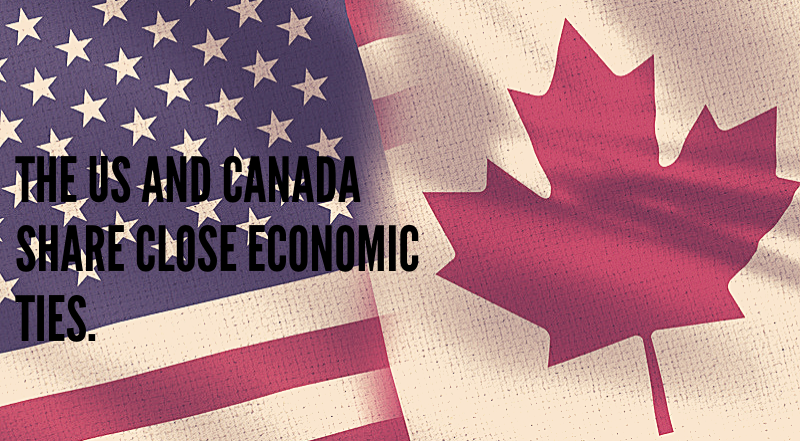
The scale of shipments passing through the US-Canada border is huge and always on the rise. Both countries have signed numerous agreements that have helped boost trade volumes.
While the US and Canada share a fraternal relationship, they are still sovereign nations with laws of their own and restrictions on the shipping of certain items.
Items Prohibited / Restricted in Canada
Explosive, radioactive, flammable, and otherwise dangerous items cannot be mailed within Canada. Also, only items that weigh less than 30 kg (66 lbs) are accepted for mailing. Illegal items that are shipped into Canada are removed from the mail stream and destroyed by the authorities. There is no option to return to the sender.
Items Prohibited / Restricted in the US
As with Canada, the US places restrictions on the shipping of certain items and bans others outright.
The following items are banned outright from international shipments:
- Explosives
- Air bags
- Marijuana whether medical or otherwise
- Ammunition
- Gasoline
- Aerosols
- Cigarettes
- Alcoholic beverages
- Poison
Cigars, medical devices, certain medicines, and lithium batteries are some restricted items.
Documentation for US-Canada Shipments
Businesses that ship between the US and Canada will need to have the following documents in order:
- A Bill of Lading that lists the goods that are part of a shipment and details about size and weight and contact information.
- A Proof of Delivery that is signed when a shipment is received in good order.
- A Commercial Invoice that is required when shipping from Canada to the US. This invoice is attached to the bill of lading and includes complete details about the products being shipped.
- A Canada Customs Invoice is required for shipments into Canada.
- A Certificate of Origin is required in both countries. This document shows the source of the shipment so that NAFTA regulations around customs duties can be complied with.
Now that you know a fair bit about the documents required for shipping between Canada and the US, the next step in your journey of enlightenment involves learning about the shipping carriers that deliver across the US-Canada border.
Carriers for US-Canada Shipments
Some major carriers that ship between the US and Canada are USPS, FedEx, UPS, Purolator, and Canada Post.
The cost you will pay on shipping through each carrier depends on factors like delivery speed, the distance between origin and destination, package size, mode of transport, value-added services, etc. Follow these links to view the pricing information of major careers:
When deciding on a carrier to handle your international shipments, doing a comparative analysis is helpful.
Unfortunately, the large carriers are famously opaque with service-related details. At LateShipment, we audit the performance of shipping carriers to ensure our customers get the service they deserve. We also help them claim refunds from their carriers for over 50 types of service failures. We save our customers up to 20% on every shipment. Signing up is free and only takes 2 minutes. Why don’t you give it a shot?
Here’s an example of the kind of valuable information we possess at LateShipment.
Shipping carriers like FedEx and UPS often claim near-perfect on-time delivery rates. Most retailers are forced to take them at their word. Unfortunately, these claims are often false.
Shipping carriers like FedEx and UPS often claim near-perfect on-time delivery rates. Unfortunately, these claims are often false.
Our audits show that the percentage of our customers’ shipments delivered late by these carriers often reaches double digits. Stats don’t lie, and we have them. Take a look at these charts.
For shipments from Canada to the US between August 2018 and January 2019, both FedEx and UPS under-performed on their claims.
During the holiday season months of November and December, FedEx delivered 7.05% and 14.53% of our Canadian customers’ shipments late. The delay rate in January 2019 was 12.87%.
Percentage Of Canadian Customers’ Shipments to the US Delayed by FedEx
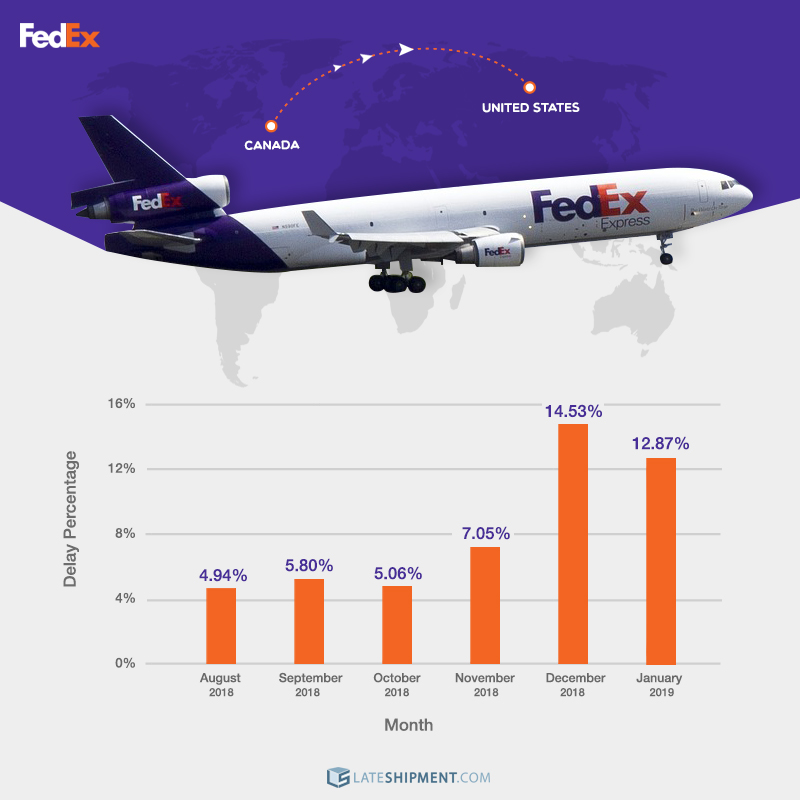
UPS had delay rates of 14.39% and 12.98% for shipments from our Canadian customers in November and December 2018. The rate for January 2019 was 16.16%.
Percentage Of Canadian Customers’ Shipments to the US Delayed by UPS
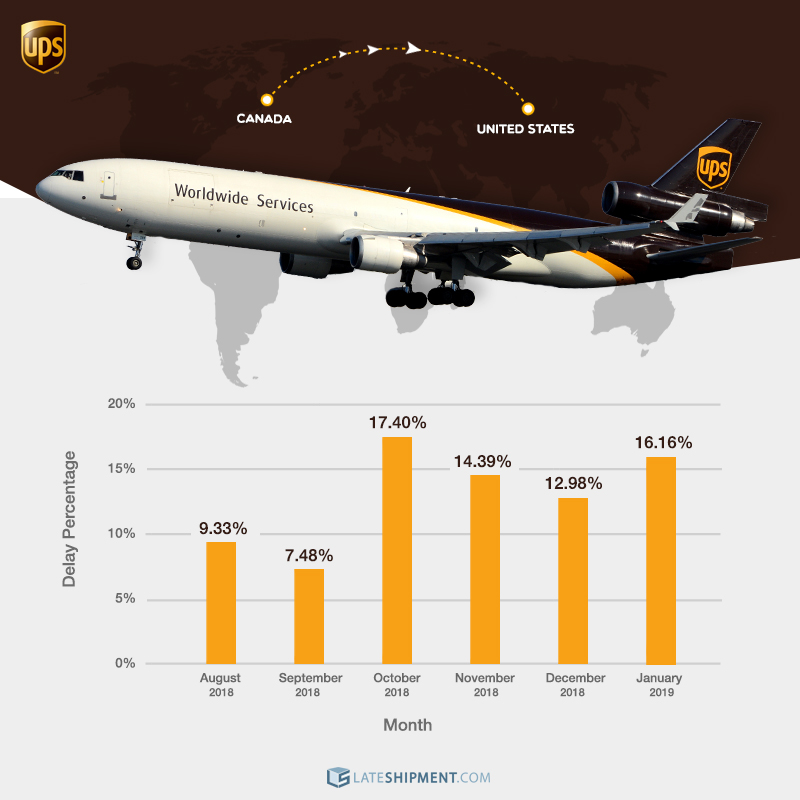
Both carriers had worse delay rates for our US customers delivering to Canada.
FedEx had a delay rate of 21.89% in November and 10.57% in December. The rate for January 2019 was 12.27%.
Percentage Of US Customers’ Shipments to Canada Delayed by FedEx
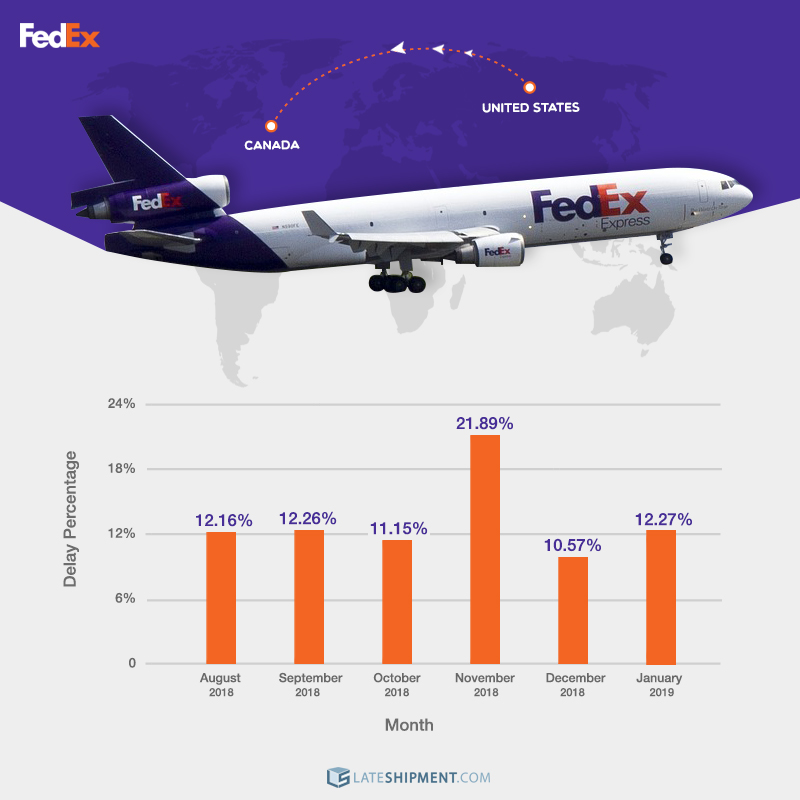
UPS, meanwhile, delivered a whopping 35.86% of our US customers shipments late in November. The rates for December and January were 25.63% and 28.76% respectively.
Percentage Of US Customers’ Shipments to Canada Delayed by UPS
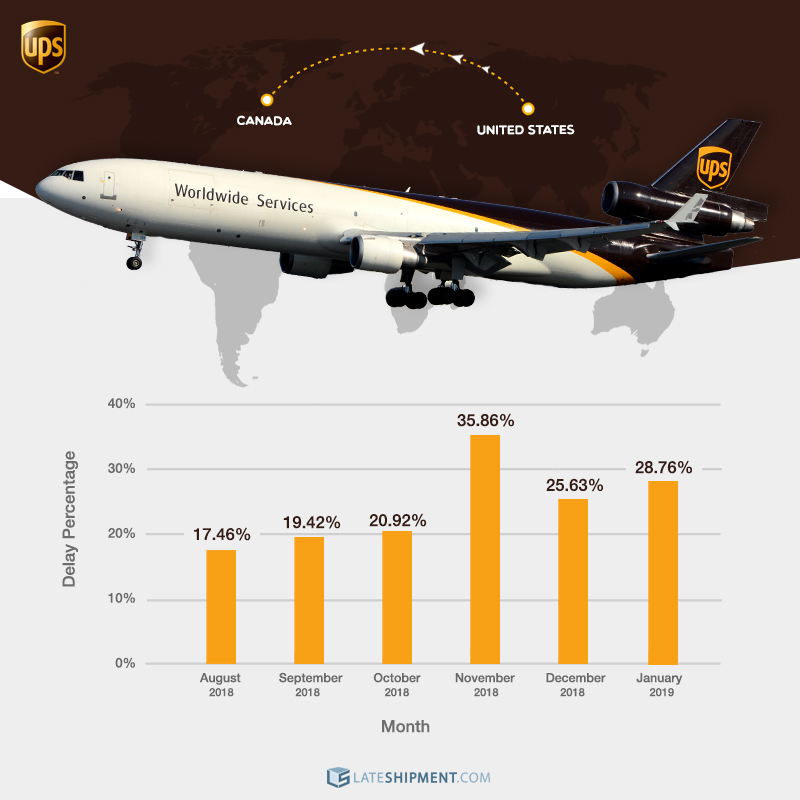
Never take shipping carriers at their word!
Once you have enough information of this kind to work with, you could consider some strategies to save money while shipping.
Great Strategies to Optimize Shipping Costs
While it’s true that international fulfillment can be costly when starting out, making the right decisions upfront will help your business save plenty.
- Stay informed of the legal requirements of the shipping process (even if you outsource).
- Include the shipping cost in the price for international customers (else YOU will have to pay).
- Be transparent about your pricing.
- Mention the delivery time clearly in order to avoid costly returns.
- Use the right kind of packaging to protect your shipments, but don’t over-package and waste money and material.
- Reuse packaging as much as possible.
- Track your packages.
- Negotiate rates assertively with your shipping carrier.
- Sign up for a service that handles refunds from your carrier for delays on their part.
- Consider insuring your shipments if you ship valuable items.
How You Could Save 20% on Shipping
Shipping across the border can open up opportunities for your business. But it also comes with many challenges like handling refunds from your shipping carrier and tracking your parcels in real time.
If you own a business that ships products, consider signing up for a free LateShipment account. LateShipment will audit your shipping invoices to identify over 50 service failures and submit refund claims to your carrier on your behalf. Businesses that use our services save up to 20% on every shipment.
That’s not all! LateShipment provides access to advanced analytics tools that will help you track every shipment in real time and fix delivery errors even before they happen. With a LateShipment account, you can rest easy in the confidence that you will be able to handle delays before they affect your customers. Visit www.lateshipment.com for more information. Signing up takes 2 minutes, and you have nothing to lose!
Common Questions on Cross-Border Shipping & International Fulfillment
1. Why is shipping to Canada so expensive?
Shipping to Canada is expensive because of the duties and taxes involved. There is also a handling fee on certain shipments. For complete information on tariffs to be paid when shipping into Canada, visit this page by the Canadian Border Service Agency.
2. Which is the cheapest way to ship from the US to Canada?
The cheapest way to ship from the US to Canada is through the USPS. Fedex and UPS have higher fees based on the service types being used. Click here for FedEx fee information.
3. How are package sizes calculated?
The basic way to calculate ground package sizes is by using the formula:
Length + 2x Width + 2x Height
For packages that are irregularly-shaped, calculate the length, width, and height from the extreme points. Visit this UPS page for more details on how package sizes are calculated.
4. Which items are banned from shipments into the US?
Some of the products banned from shipments into the US are ammunition, cigarettes, gasoline, marijuana, explosives, nail polish, dry ice, and alcoholic beverages. Certain items can be shipped as long as restrictions on their transport are fulfilled. These include medicines, cigars, and lithium batteries. The USPS has more information on this.
5. Which items are banned from shipments into Canada?
Explosive, radioactive, flammable, and otherwise dangerous items cannot be mailed into Canada. Narcotics and other controlled substances are subject to restrictions on their shipping. Perishable items like meat, vegetables, and fruit may be shipped if properly prepared and not in contravention of applicable requirements. Canada Post has more information on this.
6. What are some useful resources for international shippers?
Here are some useful resources for those wishing to ship internationally:
- PayPal on receiving payments from international customers
- Official government information for US businesses looking to go international
- The Amazon guide to selling internationally
- An introductory guide to logistics and reverse logistics
- A guide to cross-border shipping by eCommerce specialist Krista Fabregas








